
Under the Whyte notation for the classification of steam locomotives, 0-4-0 represents one of the simplest possible types, that with two axles and four coupled wheels, all of which are driven. The wheels on the earliest four-coupled locomotives were connected by a single gear wheel, but from 1825 the wheels were usually connected with coupling rods to form a single driven set.

4-4-0, in the Whyte notation, denotes a steam locomotive with a wheel arrangement of four leading wheels on two axles, four powered and coupled driving wheels on two axles, and no trailing wheels.

A 4-6-0 steam locomotive, under the Whyte notation for the classification of steam locomotives by wheel arrangement, has four leading wheels on two axles in a leading bogie and six powered and coupled driving wheels on three axles with the absence of trailing wheels.
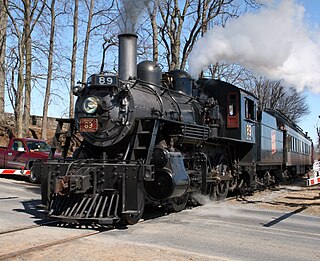
Under the Whyte notation for the classification of steam locomotives, 2-6-0 represents the wheel arrangement of two leading wheels on one axle, usually in a leading truck, six powered and coupled driving wheels on three axles and no trailing wheels. This arrangement is commonly called a Mogul.
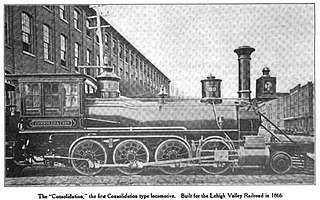
Under the Whyte notation for the classification of steam locomotives, 2-8-0 represents the wheel arrangement of two leading wheels on one axle, usually in a leading truck, eight powered and coupled driving wheels on four axles, and no trailing wheels. In the United States and elsewhere, this wheel arrangement is commonly known as a Consolidation, after the Lehigh and Mahanoy Railroad’s Consolidation, the name of the first 2-8-0.
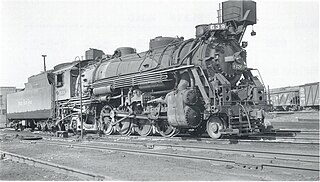
Under the Whyte notation for the classification of steam locomotives, 2-8-2 represents the wheel arrangement of two leading wheels on one axle, usually in a leading truck, eight powered and coupled driving wheels on four axles and two trailing wheels on one axle, usually in a trailing truck. This configuration of steam locomotive is most often referred to as a Mikado, frequently shortened to Mike.
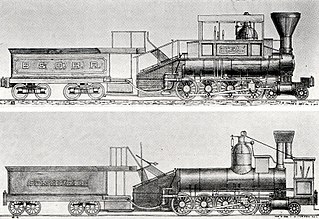
Under the Whyte notation for the classification of steam locomotives, 4-8-0 represents the wheel arrangement of four leading wheels on two axles, usually in a leading truck or bogie, eight powered and coupled driving wheels on four axles and no trailing wheels. In North America and in some other countries the type was usually known as the Twelve-wheeler.

Under the Whyte notation for the classification of steam locomotives, a 2-6-4 locomotive has two leading wheels, six coupled driving wheels and four trailing wheels.

The Cyprus Government Railway was a 2 ft 6 in narrow gauge railway network that operated in Cyprus from October 1905 to December 1951. With a total length of 76 miles (122 km), there were 39 stations, stops and halts, the most prominent of which served Famagusta, Prastio Mesaoria, Angastina, Trachoni, Nicosia, Kokkinotrimithia, Morphou, Kalo Chorio and Evrychou. The CGR was closed down due to financial reasons. An extension of the railway which was built to serve the Cyprus Mines Corporation operated until 1974.
Under the Whyte notation for the classification of steam locomotives by wheel arrangement, 2-4-0+0-4-2 is an articulated locomotive, usually of the Garratt type. The wheel arrangement is effectively two 2-4-0 locomotives operating back to back, with the boiler and cab suspended between the two power units. Each power unit has two leading wheels on one axle, four powered and coupled driving wheels on two axles and no trailing wheels. A similar wheel arrangement exists for Mallet locomotives, but is referred to as 2-4-4-2 since only the front engine unit can pivot.
The Union of South Africa was established on 31 May 1910 in terms of the South Africa Act, which unified the former Cape Colony, Natal Colony and the two colonised former republics, the Transvaal and the Orange Free State. One of the clauses in the Act required that the three Colonial Government railways, the Cape Government Railways, the Natal Government Railways and the Central South African Railways, also be united under one single administration to control and administer the railways, ports and harbours of the Union. While the South African Railways (SAR) came into existence in 1910, the actual classification and renumbering of all the rolling stock of the three constituent railways required careful planning and was only implemented with effect from 1 January 1912.

Locomotives and train sets of Sri Lanka Railways consist mostly of diesel locomotives and multiple units. Steam locomotives are no longer used, except on heritage trains, such as the Viceroy Special.
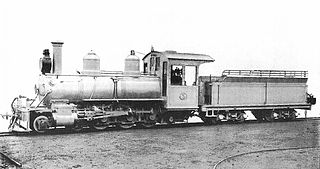
The South African Railways Class NG8 4-6-0 of 1904 was a narrow-gauge steam locomotive from the pre-Union era in the Cape of Good Hope.
The CGR class C1 and C1a were steam locomotives of the Garratt type built by Beyer, Peacock & Company, England for the Ceylon Government Railways (CGR), now Sri Lanka Railways. The Class C1 prototype was built in 1928 and was followed by eight Class C1a locomotives in 1946. The C1a class was converted to oil firing between 1950 and 1954.

The Main Line is a major railway line in the rail network of Sri Lanka and considered by many to be one of the most scenic train journeys in all of Asia. The line begins at Colombo Fort and winds through the Sri Lankan hill country to reach Badulla.

The Cape Government Railways 4th Class 4-4-2 of 1897 was a South African steam locomotive from the pre-Union era in the Cape of Good Hope.

The Cape Government Railways NG 4-6-2T of 1908 was a South African narrow-gauge steam locomotive from the pre-Union era in the Cape of Good Hope.
Uda Pussellawa Railway (UPR) or Udupussallawa Railway (Sinhala: උඩුපුස්සැල්ලාව දුම්රිය මාර්ගය Uḍupussællāwa Dumriya Mārgaya) was a 2 ft 6 in (762 mm) narrow gauge railway line that existed in Ceylon (now Sri Lanka) between 1903 and 1948. The line connected Nanu Oya railway station with Ragala via Nuwara Eliya.

The Nanu Oya railway station is the 63rd station on the Main Line, and is 206.9 km (128.6 mi) away from Colombo. All trains including Podi Menike and Udarata Menike express trains service the station. The station was a junction and branching point for the Udupussallawa narrow gauge railway line connecting Nanu Oya with Ragala via Nuwara Eliya.

The Indian locomotive class WDM-3D is a class of diesel-electric locomotive that was developed in 2003 by Banaras Locomotive Works (BLW), Varanasi for Indian Railways. The model name stands for broad gauge (W), Diesel (D), Mixed traffic (M) engine with 3300 horsepower (3D). The engine is classified WDM-3D though it outputs only 3300 hp and not 3400 hp as the name should suggest. They entered service in 2003. A total of 590+ WDM-3D were built at Banaras Locomotive Works (BLW), Varanasi between 2003 and 2016.
















